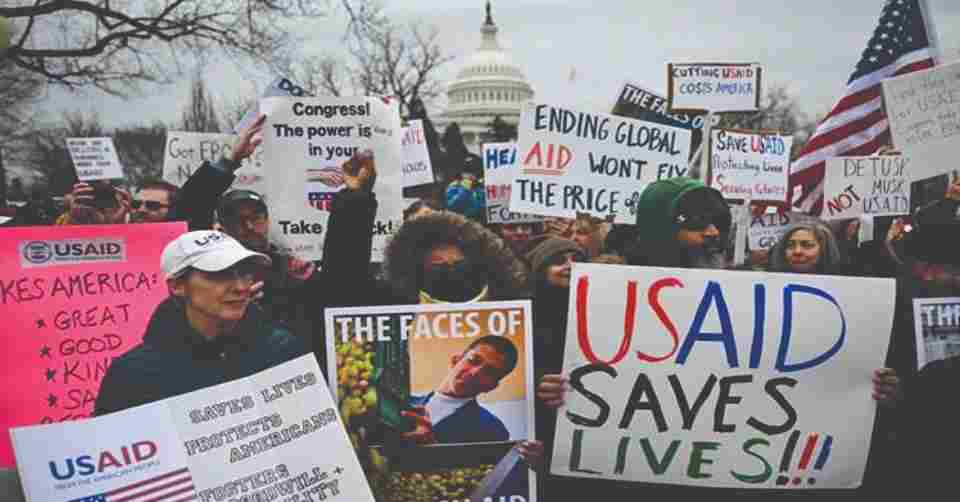Trump’s USAID Shutdown Halts Global Aid Efforts
"I appreciate the attention on Ukrainian media," Bihus said. "But most of this money went toward crucial state functions."

When Donald Trump assumed the presidency on January 20, Anne Linn was a senior community health adviser at the President’s Malaria Initiative (PMI), a crucial program under the United States Agency for International Development (USAID).
With two decades of experience in 30 sub-Saharan African countries, Linn found her work deeply meaningful and impactful.
However, within days of the new administration, her career took a drastic turn.
On his first day in office, Trump signed an executive order freezing new foreign aid commitments, halting critical health initiatives.
Four days later, a 90-day freeze on existing foreign development aid followed, sparking fears among health professionals about the future of life-saving programs.
Almost overnight, Linn’s work stopped. Healthcare workers in Nigeria, Kenya, and Cameroon were forced to cease operations.
The supply chain for malaria medication collapsed. USAID and PMI websites went offline. Then, on January 28, Linn and 390 of her colleagues were laid off.
“I was stunned,” Linn said. “The waste and cruelty of it all is unimaginable. My entire professional world vanished with a single stroke of a pen.”
Children’s Lives in Danger
The PMI website now displays a message stating it is under review for compliance with the president’s executive orders.
USAID’s website has been reduced to a single page, announcing that, as of February 7, 2025, at 11:59 pm EST, all direct-hire personnel will be placed on administrative leave, except for a select few managing mission-critical tasks.
Trump handed oversight of USAID to billionaire Elon Musk, who labeled the agency a “criminal organization” and declared it “time for it to die.”
Before the freeze, PMI had helped save 11.7 million lives and prevented 2.1 billion malaria cases since 2000.
“Malaria prevention is time-sensitive,” Linn wrote in a viral Facebook post. “Delays in distributing bed nets and preventive medicine will cost children their lives.”
USAID was responsible for foreign aid, disaster relief, and international development.
Though foreign aid comprises less than 1% of the U.S. federal budget, America remains the world’s largest donor, providing 42% of global humanitarian aid in 2024, according to the United Nations.
The abrupt funding halt has left frontline aid workers and millions of people dependent on U.S.-funded programs in crisis.
Many countries lack the resources to replace USAID’s contributions, and finding alternative donors could take years.
Humanitarian organizations that rely on grants now face an uncertain future.
A Partial Reprieve
On January 29, Secretary of State Marco Rubio, USAID’s acting leader, issued a waiver allowing “life-saving humanitarian assistance” to continue during the review period. This includes essential medicines, food, and shelter. However, Linn and her colleagues have yet to resume their work. Aid organizations remain in limbo, unsure whether their programs qualify under the exception.
“It’s chaos,” said Jesse Marks, a senior advocate at Refugees International. “Organizations are trying to contact USAID for guidance, but there’s no one left to answer. If thousands of waiver requests flood in from different regions, who decides which ones are truly life-saving?”
Fallout in Ukraine
Ukraine is also reeling from the aid freeze. U.S. assistance supported a range of projects, from veteran rehabilitation to anti-corruption efforts and infrastructure development.
With Russia’s invasion ongoing and Ukraine’s budget stretched thin, the halt could have devastating consequences.
Independent media outlet Bihus Info, based in Kyiv, relied on USAID for 65% of its funding. Director Denys Bihus received notice in late January that all USAID-supported projects would be suspended. “It wasn’t life-shattering, but it was tough,” he said. While a surge in public donations provided temporary relief, he admitted, “That money will only last a few weeks.”
Ukraine’s media landscape was already fragile, with war threatening independent journalism. Now, regional outlets monitoring local budgets and corruption may disappear entirely. “People need to eat,” Bihus said. “Ukraine is losing professionals it may never get back.”
Although military aid to Ukraine remains intact, funding for energy sector support—vital in a country under constant Russian attack—remains in question.
“I appreciate the attention on Ukrainian media,” Bihus said. “But most of this money went toward crucial state functions.”
He hopes to sustain his newsroom for three months but acknowledges the future is uncertain. “Ask me again at the end of March,” he joked.
